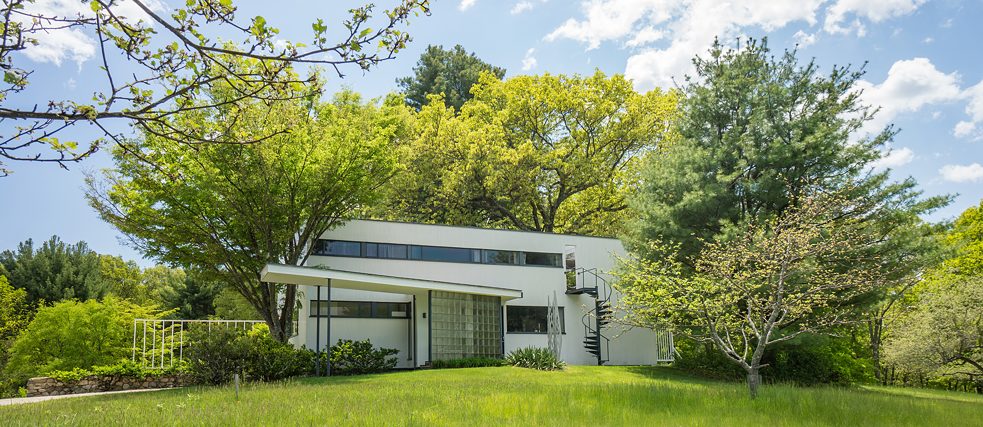A New England “antiquity”
The Gropius House in Lincoln, Massachusetts

German architect Walter Gropius (1883-1969), founder of the German design school known as the Bauhaus, built the Gropius House as his family home in Lincoln, Massachusetts, in 1938, after Gropius had accepted a teaching position at Harvard Graduate School of Design in Architecture.
By Wendy Hubbard
Walter Gropius, his wife Ise and their adopted daughter Ati arrived in the United States with little more than their Bauhaus furniture, books and personal belongings. They found a Colonial-style house to rent on Sandy Pond Road in Lincoln, Massachusetts, but Ise later wrote, “Our Bauhaus furniture looked indeed strange in the small rooms of this prim little house of Colonial style.”
New social connections brought an extraordinary opportunity: Henry Shepley, an architect friend, approached philanthropist and patron of the arts Helen Storrow, informing her that “the new German professor” at the Harvard School of Design was ‘desperate’ to build a house for himself but was not in the financial position to do so. Mrs. Storrow thought that newly arrived immigrants should always be given a chance, so she offered Gropius a building site and the financial resources to build his house, because as she put it, “if it is good, it will take root.” Gropius chose four acres on a small hill surrounded by Mrs. Storrow’s apple orchard.
Tradition and Innovation Combined
In designing the house, Gropius combined traditional elements of New England architecture with new, innovative materials. The design of the Gropius House is consistent with Bauhaus philosophies of simplicity, functionality, economy, geometry, and aesthetic beauty determined by materials rather than applied ornamentation.At the Bauhaus, Gropius brought together a faculty of celebrated artists that included Josef Albers, Wassily Kandinsky, Paul Klee, Laszlo Moholy-Nagy, Herbert Bayer, Anni Albers, Marianne Brandt, Alexander Schawinsky, Gunta Stolzl and Marcel Breuer, among others. At the Gropiuses’ Lincoln home guests included their Bauhaus friends and fellow émigrés as well as other notables of the twentieth century: Alexander Calder, Joan Miro, Igor Stravinsky, Henry Moore, Demetri Hadzi, and Frank Lloyd Wright are just a few names in the Gropius guest book.
The guest book pages, now digitally scanned along with a collection handmade artist’s cards, are charming, personal, and delicate. These works on paper are highlights of the interactive kiosk exhibit for the Bauhaus 100 celebration at Gropius House. Walter and Ise Gropius promoted modern architecture and Bauhaus principles of design by using their family home as a teaching tool.
An Important Part of the New England Architectural Continuum
The final wishes of Walter Gropius, best expressed in his own words, “It would be beautiful if all my friends of the present and the past would get together in a little while for a fiesta – a la Bauhaus – drinking, laughing, loving. Then I shall surely join in. It is more fruitful than graveyard oratory. Love is the essence of everything. Ise, you whom I have loved the most, please put in order and manage my spiritual heritage; as to the property on hand, handle it as you see fit. Remember Ati, whom I love.”When Gropius died in July 1969, Mrs. Gropius acted on her husband’s intent by donating his Bauhaus and Harvard materials to those archives respectively, as well as donating art to the Harvard Art Museum and to the Bauhaus Archiv in Berlin. Mrs. Gropius chose to give the house and their personal property to the Society for the Preservation of New England Antiquities, now Historic New England, in 1979, but continued to live in the house until her death in 1983.
She recognized that the Gropius House was, and continues to be, a New England house and an important part of the New England architectural continuum. In a charming anecdote, Mrs. Gropius was always amused to think of the Gropius House as a New England “antiquity.” The ongoing stewardship of Historic New England insures that the Gropiuses’ vision of preservation and education would carry on into the future.